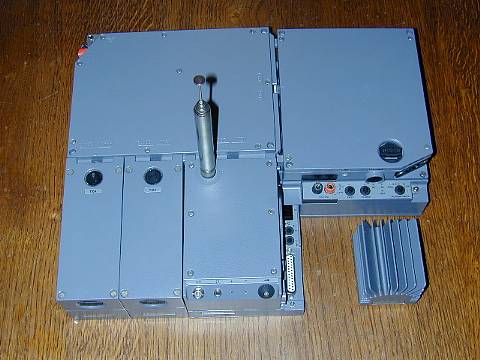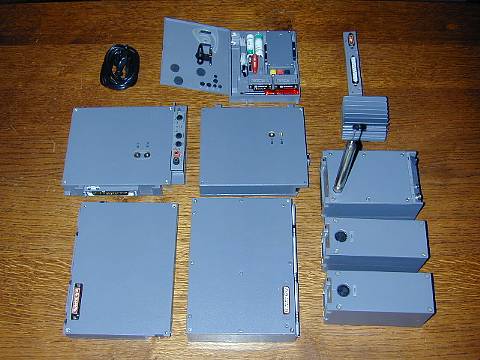| |
Funk-Station FS 5000
(translation of the original article in german language on the homepage
www.agentenfunk.cabanova.de
by Helmuth "Jimboy" Meyer, DJ2EI)
In the beginning of the 80's was developed soon after the SP 20, a new
follow-up type. TELEFUNKEN (who later integrated into DAIMLER Benz Aerospace/EADS
and now as TELEFUNKEN RACOMS was responsible, an
important pioneer of German communications technology. The new equipment was
intended for the Federal Intelligence Service and for special-forces of the
German Federal Armed Forces and Security /Intelligence organizations of
other NATO partners. The devices were painted in grey or olive RAL 6014.
The American NSA (National Security Agency) supplied devices were called "FIELD
SET FS 5000". Some of these units were used in "Operation Desert Storm" at
the beginning of the 90's and were tested and for "usable" have not been
found! Why did they function then however with the Federal Intelligence
Service? Was it perhaps probably because of a certain "fine fuehligkeit" of
the German operators ? A technically very similar system, which became the
HRM 7000 HF radio system, later by TFK RACOMS for the MIL market were
produced. There is one luggage version with 25 W, mobile and stationary
versions with 400 W for CW, SSB and data communication with various MODEM's,
ALE etc. as well as a Communications computer and a Crypto terminal. The FS
5000 is (from individual modules built in microelectronics with flat pack
IC's) a plug together unit in the frequency range from 500 kHz to 29.999 MHz
(receive) as well as 2 MHz to 29.999 MHz (transmit) in 1 kHz steps. The mode
of operation is data communication QPSK (fast single tone teletype), CW (A1)
like it otherwise (historical-typical-classically) with such devices was
usual and it also has no SSB transmit mode. The technology overhauled in the
meantime thus also the use of High speed Morse transmission. Semi duplex
operation is possible, thus using different sending and receiving
frequencies. The assembled entire unit fits into an Attaché suit-case or a
laptop bag of approx. about 15 kg weights 350 x 300 x 80 mm, it. Two 14.4
Volt/1,2 Ah nickel cadmium batteries (in parallel, thus 2.4 Ah) serve for
the current supply. The minimum operating configuration for sending and
receiving consists of the Transmitter Control/Crypto module, the transmitter
with antenna tuner, the receiver and both NiCad batteries, (thus without the
current supply/battery charger), which reduces the total weight
substantially.
Receiver “R”
The receiver "R" is ready for operation without the transmitter "T" with
a telescopic antenna, CW and radio data transmission with 300 Hz IF filter
or voice and radio data transmission with 3000 Hz IF filter in the upper
sideband. The filters in the 2nd IF of 200 kHz (typical for TELEFUNKEN
devices) are mechanical filters. For the 1st IF of 50.200 MHz, a crystal
filter is used. The receiver operating in the pure reception setup uses the
connector part "H" adapter plug with one14.4 V NiCad battery "B". The
telescopic antenna is 1 meter long. When screwing the antenna in a HF
preamplifier with three transistors is activated automatically via a switch
in the screw base. The frequency, which is indicated with a 5 digit LED, can
with an automatic controller (delta f) can be adjusted over approx. +/- 300
Hz. There are also two red LED's available marked with + and - and are used
for tuning indications for RTTY function. The shifts between + and – of
about 100 Hz amount to frequencies of 1140 Hz and 1240 Hz. A further red LED
"!" warns that the receive frequency is not locked or the battery voltage is
too low. When switching on the LED display shows "OO.OOO". The earphone is
attached to a small 3.5 mm plug. The AF pass band is from approx. 600 Hz to
2.7 kHz. An automatic controller for the volume completes the small diagonal
front panel on the left side of the receiver. In front right beside the
DB-25 socket (the connector for the Transmitter Control/Crypto Module) are
two push-buttons (place and value) for the setting of the receive frequency
as well as right beside it the LED with 5 digits display is. Besides the
change over switch for the IF filter bandwidth 300 Hz/3000 Hz and again
right beside it the power switch for the receiver.
Transmitter “T”
The transmitter "T" consists of the actual transmitting unit using
normal transistor technology with approx. 30 W HF power. As a driver an
MRF134 is used and in the output stage an ON 4347. After the PA are band
pass filters, within the range of 2-3, 3-4, 4-6, 6-8, 8-12, 12-16 and 16-20
MHz. Frequencies over 20 MHz do not go through a band pass filter, it
directly passes to the antenna tuning equipment "A". After the
transmitter an automatic antenna tuning equipment "A" follows which is
installed on the transmitter. As an antenna a simple wire antenna (random
wire) is used with a length of approx. 15 meters, which can be stretched as
a long wire, diagonal wire, or inverted Vee. The principal item of the
station is the Transmitter Control/Crypto module using microprocessor
technology, that the transmitter in all its functions controls (frequency,
transmitting time, etc.) and additionally contains data encryption by
software.
Antenna Tuner “A”
The antenna tuner equipment "A" is controlled with a microprocessor of
the type "NSC 800" (with a Clock frequency of 2.4576 MHz as well as an "MMC
27C32" EPROM to unite "NSC 810" I/O chips) and switches 11 coils and 8
condensers using relays. A VSWR measuring circuit gives a feedback to the
transmitter "T" for the reduction of the transmitting power with bad VSWR.
The tuning process lasts approx. 1.5 seconds on average depending upon
frequency and wire length.The antenna is attached with a banana plug on the
tuning equipment at the red socket, the counterpoise on an earth screw.
Transmitter Control/Crypto Module
The principal item of the station FS 5000 is the Transmitter Control/Crypto
module. It is equipped with a microprocessor of the type NSC 800 or NSC 880
and appropriate EPROM, I/O chips etc. The module is connected by a DB-25
connector to the receiver "R" and connected by this further to the
transmitter "T". On the cover is a mini keyboard for the input of frequency,
text, transmitting time etc. as well as a display. The station could be
controlled via the time, i.e. a message entered into the memory was coded
and sent automatically at a pre-determined time. Likewise receipt of a
message without presence of the agent was possible, the text in the
Transmitter Control/Crypto module was stored using two 3.5 V AA lithium
batteries. The agent needed to remove only the control unit of the hidden FS
5000, i.e. pull the large, black lever to unlock. Note: With all FS 5000
present on the Surplus market the Transmitter Control/Crypto Module was
removed for secrecy reasons and shredded. Also the entire documents, user
manuals, pictures, descriptions and connection diagrams as a lot were
destroyed!!!
Power Supply/Battery Charger “M” and “C”
The power supply/battery charger consists of a 110-240 V switch mode
power pack "M" and the battery charger "C", an external 12 V DC input for an
external battery of the KFZ or boat can be connected. Using these units the
NiCad batteries "B" are charged. The switch mode power pack "M" is fastened
onto the battery charger "C". The power supply/battery charger is not
necessary, if the station is to be operated only with the two NiCad
batteries "B". Only the charging of the NiCad batteries from the mains must
be made with the power supply/battery charger. An on-off switch for the
entire station is missing! A holder for a spare fuse is on the top
side of the switch mode power pack, the socket for the mains cable (with
electric shaver plug) at the right front. On the battery charger are two
push button switches for the change rate "fast" or "normal charge" (1 hr or
10 hr Std.) as well as a further push button for control of the charge of
the batteries, which is indicated by two LED's "full" or "low". A NiCad
battery while charging is likewise indicated if too hot with an LED. The
Ni-Cad batteries "B" becomes before the charging with unload-hurries "F"
discharger. The charge of a NiCad battery "B" can be examined also with the
test connector "S" and is indicated with a green LED.
Accessory Box
An accessory box (in the size of the CONTROLLER, on which it normally
was) contains an earphone, the telescopic antenna for the receiver, two
screwdrivers (large small), various safety devices, two 3.5 V AA lithium
batteries for the MEMORY in the Transmitter Control/Crypto module, two
banana plugs, the transmitter test adapter/dummy load "X" as well as two
NiCad battery test connectors "S" with green LED.
|
|
|

